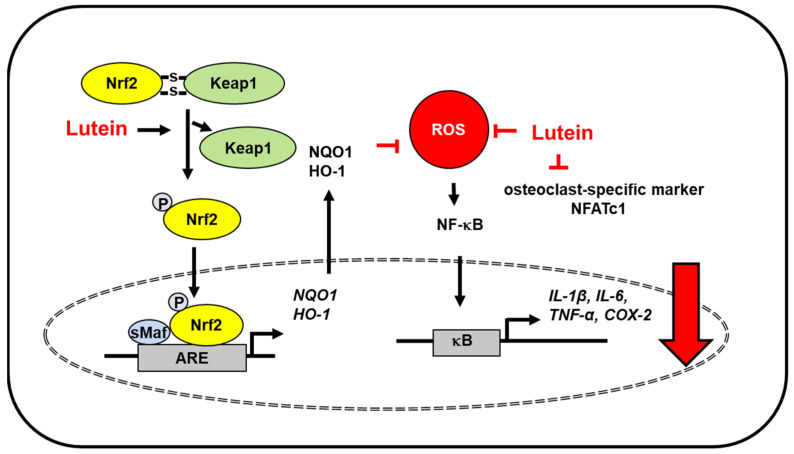Figure 3.
The proposed mechanism by which lutein inhibits oxidative stress-induced inflammatory responses in bone. ROS levels increase in monosodium iodoacetate-induced osteoarthritis in primary chondrocyte cells and femur tissues of ovariectomized rats (osteoporosis model). Lutein reduces ROS levels and inhibits ROS-mediated activation of NF-kB and the expression of inflammatory mediators (IL-1β, IL-6, TNF-α, COX-2). Moreover, lutein increases dissociation of Keap1 from Nfr2/Keap1 complex and thus, promotes nuclear translocation of Nrf2, which forms a heterodimer with sMaf protein and binds to the regulatory region of DNA called ARE. It induces the expression of Nrf2- target antioxidant genes (HO-1, NQO1). These antioxidant enzymes reduce intracellular ROS levels, which suppresses inflammatory responses [58,59]. In addition, lutein inhibits osteoclast-specific marker NFATc1 in the bone of ovariectomized rats [59]. Thus, lutein prevents oxidative stress-mediated osteoarthritis and bone deterioration. ARE, antioxidant response element; COX-2, cyclooxygenase-2; HO-1, hemeoxygenase-1; IL, interleukin; Keap1, kelch like ECH associated protein 1; NF−κB, nuclear factor-κB; Nrf2, nuclear factor erythroid 2–related factor 2; NQO-1, NAD(P)H:quinone oxidoreductase 1; NFATc1, nuclear factor of activated T cells 1; ROS, reactive oxygen species; sMaf, small Maf; TNF-α, tumor necrosis factor-α.

